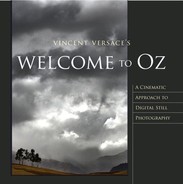Selective Neutral Density Using Lighting Effects
If you are working in Photoshop CS or CS2, you have gone as far as you can go working in 16-bit color. As noted before, digital image artifacting is cumulative, and every time you do something in Photoshop, you are dumping data and creating artifacts that you don’t want seen in your final print. So you’ll convert the image from 16-bit to 8-bit. You will then exploit a little-known side of Photoshop’s Render > Lighting Effects filter. You are going to use the Lighting Effects filter in a way that the engineers at Adobe may not have intended: not to light the image, but to de-light it.
Step 1: De-Lighting with the Lighting Effects Filter
1. | Select “Save As” From the file pull-down menu. Name the new file BLUE MASTER FLOWER LIGHTING 8BIT.psd. Turn off the layers in the Save As option box. Close the file BLUE MASTER FLOWER 16BIT.psd and open the file BLUE MASTER FLOWER LIGHTING 8BIT.psd. Convert the image from 16-bit color to 8-bit color (Image > Mode > 8 Bits/Channel). Duplicate the background layer, rename it LIGHTING ND (for neutral density), and save the file. |
2. | Choose Filter > Render > Lighting Effects. As a style, select Soft Omni. Click the center point and drag it to the middle of the upper-left flower (Figure 3.26a). |
3. | Click the lower anchor point of the circle, and drag it until the circle is about the same size as the upper-left flower (Figure 3.26b). Figure 3.26b.
|
4. | |
5. | Under Light Type, lower Intensity until the flower is no longer blown out. For this image, the percentage is 25. |
6. | Under Properties, increase the exposure from the default of –8 to where the left flower is again lit; for this image that’s 9. Click OK. |
Step 2: Marking the Lighting Image Map
In black-and-white silver photography, printers sometimes slightly darken the edges of a print to draw the viewer’s eye to the center of the picture. To apply that technique here, give the outer edges a value of 20%. This also makes the image appear more three-dimensional.
1. | Create a new image map layer named LIGHTING ND IM, select the Pencil tool, and write with a new color. (I chose yellow.) |
2. | To deepen the greens, outline those areas on the image map and assign them a value of 25%. To slightly darken the periphery of the blue-purple area behind the main flowers, assign them a value of 10%. Leave the top ridge alone and give it a value of 0% (Figure 3.27a). Figure 3.27a.
|
3. | Now, move on to the flowers. You added some light to this image when you put the Soft Omni light on the upper-front flower, so let’s use it. Give this area a value of 50%. In the process, you darkened all the areas around the front flower, so give the back flower a value of 50% as well. The difference here is that you will be darkening, not lightening as you did with the front left flower. |
4. | Leave the lower left flower alone, and consider the buds. To concentrate on the play of real light and shadows and promote the three-dimensional appearance, assign the buds a value of 50% (Figure 3.27b). Figure 3.27b.
|
5. | Make LIGHTING ND active again, add a black-filled mask, and do the brushwork (Figures 3.27c, 3.27d, and 3.27e). Figure 3.27c.
Figure 3.27d.
Figure 3.27e.
Here is what appears on the layer mask (Figure 3.27f). Figure 3.27f.
|
6. | What you have done is a little too dark (Figure 3.27g), so reduce the opacity of the layer to 51%. Select the Screen blending mode. (Remember that the Screen blending mode halves the density of the image, whereas the Multiply blending mode doubles the density.) Figure 3.27g.
|
Step 3: Increasing Saturation in the LAB color space
1. | |
2. | Now open the file BLUE MASTER FLOWER LIGHTING LAB 8BIT.psd. Go to Image >Mode and select LAB. You have just converted the file to the LAB color space. |
3. | Create a Curves adjustment layer. (Be sure to Alt-/Option-click on the grid to get the small grid.) Select “a.” Move the top and bottom anchor points over one grid line. |
4. | Now Select “b.” Move the top anchor point over one grid line and the bottom over one grid line. Make a Master layer (do “The Move”). Save the file. |
5. | Shift-drag the Master layer onto the BLUE MASTER FLOWER LIGHTING 8BIT.psd file. Name this layer LAB. |
6. | Ctrl-click on the layer mask of the LIGHTING layer. Go to Select > Inverse (Shft-Ctrl-I/Shft-Cmd-I) and create a layer mask on the LAB layer. The color is still a little too “deep,” so lower the layer’s opacity. For this image it’s 75%. |
7. |











